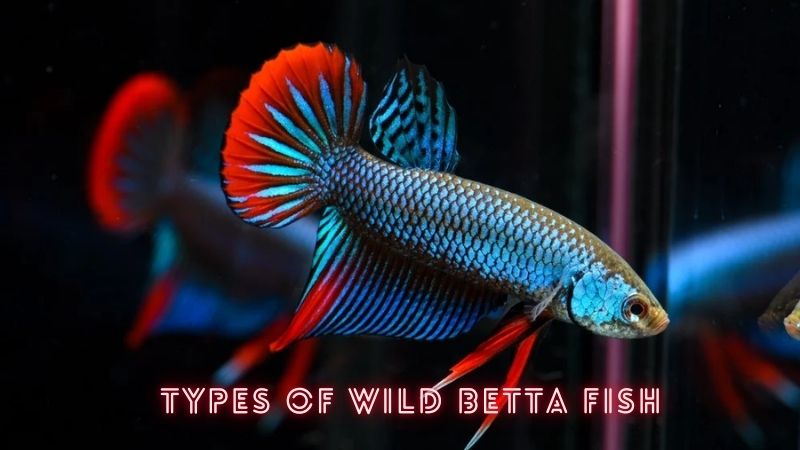Types of Wild Betta Fish. Betta fish, often referred to as Siamese fighting fish, are well-known for their vivid colors and flowing fins. However, what many people may not realize is that the Betta splendens commonly seen in pet stores are just one member of a much larger family of betta species. Wild bettas, which are native to Southeast Asia, exhibit a variety of colors, shapes, and behaviors that differ significantly from their domesticated counterparts. In this article, we’ll explore the diverse world of wild betta fish and highlight some of the most intriguing species. In this article, Tropical Fish Haven explore the diverse types of wild betta fish and highlight some of the most intriguing species.
Types of Wild Betta Fish
Betta splendens (Siamese Fighting Fish)
While Betta splendens is the most recognized species due to its popularity in the aquarium trade, the wild form of this species is quite different from the selectively bred varieties. Wild Betta splendens typically have shorter fins and less intense coloration compared to their ornamental cousins. They are found in shallow waters such as rice paddies, canals, and floodplains in Thailand, Cambodia, and Vietnam. In their natural habitat, these fish display more muted colors like greens, browns, and blues, which provide camouflage against predators.
Betta smaragdina (Emerald Betta)
Betta smaragdina, also known as the Emerald Betta, is native to northeastern Thailand and Laos. True to its name, this species exhibits a beautiful iridescent green coloration, which can appear blue or turquoise under different lighting conditions. The males often display striking metallic bodies with red accents on their fins. Betta smaragdina prefers slow-moving or still waters, such as swamps, ponds, and rice fields. They are known for their peaceful nature compared to other betta species, making them a favorite among wild betta enthusiasts.
Betta imbellis (Peaceful Betta)
Betta imbellis, commonly known as the Peaceful Betta or Crescent Betta, is native to Malaysia, Indonesia, and southern Thailand. As their name suggests, these bettas are less aggressive than Betta splendens, making them more suitable for community tanks. They have a distinctive crescent shape on their tails and display beautiful blue and green iridescence with red highlights. Betta imbellis can be found in acidic waters, often in peat swamps and slow-moving streams rich in vegetation.
Betta mahachaiensis (Mahachai Betta)
The Betta mahachaiensis is a relatively newly recognized species, discovered in the Mahachai region of Thailand. This species inhabits brackish waters, which is unusual for bettas. They exhibit striking blue and green iridescence with black markings on their bodies and fins. Betta mahachaiensis are known for their resilience to fluctuating water conditions, a trait that makes them particularly interesting for study. Their natural habitat includes mangroves, swamps, and canals with varying salinity levels.
Betta albimarginata (White-Edged Betta)
Betta albimarginata, or the White-Edged Betta, hails from Borneo, specifically the Indonesian part of the island. This species is known for the distinctive white edges on the fins of the males, which contrast beautifully with their reddish-brown bodies. Betta albimarginata prefers blackwater environments, where the water is stained dark by tannins from decomposing leaves and other plant material. These habitats are often found in slow-moving streams and peat swamps.
Betta macrostoma (Brunei Beauty)
Betta macrostoma, also known as the Brunei Beauty, is one of the most visually stunning and sought-after wild bettas. Native to Brunei, this species is characterized by its large mouth, hence the name “macrostoma,” which means “large mouth” in Greek. Males exhibit vibrant red bodies with black vertical stripes and iridescent blue-green markings. Betta macrostoma inhabits clear, slow-moving waters with dense vegetation. They are known for their intricate courtship displays and mouthbrooding behavior, where males carry the eggs in their mouths until they hatch.
Betta channoides (Snakehead Betta)
Betta channoides, often referred to as the Snakehead Betta due to its resemblance to snakehead fish, is native to the blackwater streams of Borneo. This species is relatively small, with males displaying vivid red and orange colors and distinctive black banding on their fins. Betta channoides prefers acidic, tannin-rich waters with plenty of leaf litter and vegetation. Like many wild bettas, they are mouthbrooders, with males taking on the role of incubating the eggs.
Betta picta (Picta Betta)
Betta picta, or the Picta Betta, is found in Indonesia, particularly on the islands of Java and Sumatra. This species is less colorful than some of its relatives, with more subdued brown and green tones that help it blend into its environment. Betta picta is often found in slow-moving streams and ponds with abundant plant cover. They are known for their peaceful demeanor and are one of the more easily bred wild bettas in captivity.
Betta rutilans (Red Betta)
Betta rutilans, known as the Red Betta, is a small, vibrant species from the blackwater habitats of Borneo. The males are particularly striking, with bright red bodies and clear fins edged in black. Betta rutilans thrives in soft, acidic water with dense vegetation and plenty of hiding spots. Their diminutive size and beautiful coloration make them a favorite among betta enthusiasts who appreciate the more natural look of wild species.
Betta foerschi (Foersch’s Betta)
Betta foerschi is another stunning species from Borneo, named after German ichthyologist Dr. Jürgen Foersch. This species is known for its brilliant blue and green iridescence, often accompanied by red accents on the fins and body. Betta foerschi inhabits blackwater streams and peat swamps, preferring environments with plenty of plant cover and soft, acidic water. They are relatively peaceful and can be kept in pairs or small groups under the right conditions.
Conclusion
The world of wild betta fish is incredibly diverse, offering a glimpse into the natural beauty and complexity of these remarkable creatures. From the vibrant Betta macrostoma to the peaceful Betta imbellis, each species has its own unique characteristics and habitat preferences. By exploring and understanding these wild species, aquarists can gain a deeper appreciation for the natural history and ecological significance of betta fish. Whether you are a seasoned betta enthusiast or a newcomer to the hobby, the fascinating variety of wild bettas provides endless opportunities for discovery and enjoyment. Don’t forget to follow Tropical Fish Haven to update the latest articles!





